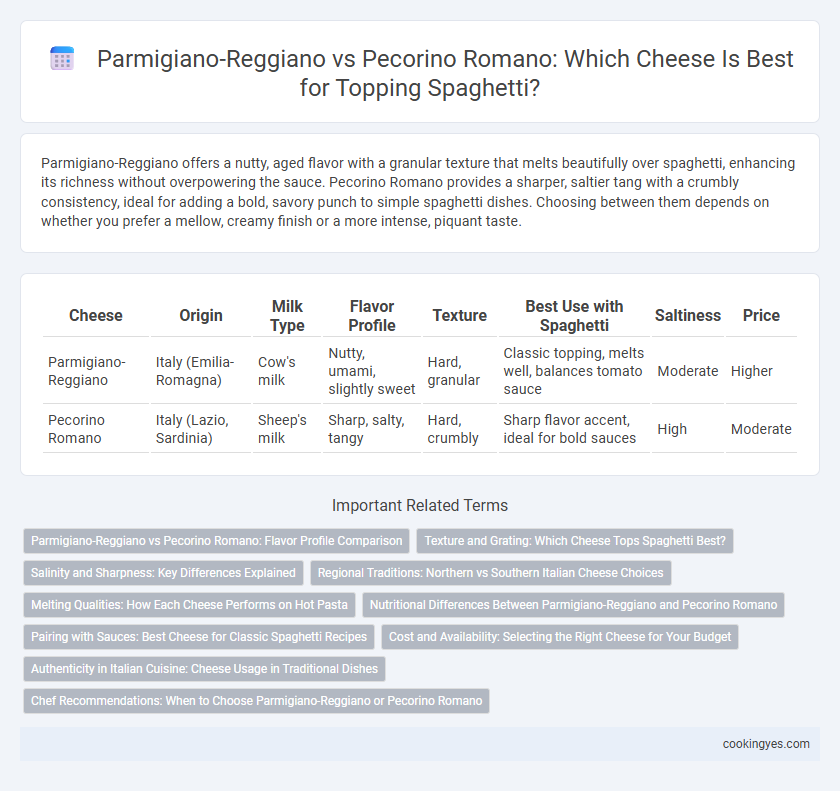Parmigiano-Reggiano offers a nutty, aged flavor with a granular texture that melts beautifully over spaghetti, enhancing its richness without overpowering the sauce. Pecorino Romano provides a sharper, saltier tang with a crumbly consistency, ideal for adding a bold, savory punch to simple spaghetti dishes. Choosing between them depends on whether you prefer a mellow, creamy finish or a more intense, piquant taste.
Table of Comparison
| Cheese | Origin | Milk Type | Flavor Profile | Texture | Best Use with Spaghetti | Saltiness | Price |
|---|---|---|---|---|---|---|---|
| Parmigiano-Reggiano | Italy (Emilia-Romagna) | Cow's milk | Nutty, umami, slightly sweet | Hard, granular | Classic topping, melts well, balances tomato sauce | Moderate | Higher |
| Pecorino Romano | Italy (Lazio, Sardinia) | Sheep's milk | Sharp, salty, tangy | Hard, crumbly | Sharp flavor accent, ideal for bold sauces | High | Moderate |
Parmigiano-Reggiano vs Pecorino Romano: Flavor Profile Comparison
Parmigiano-Reggiano offers a nutty, salty flavor with a granular texture that enhances the richness of tomato-based spaghetti sauces. Pecorino Romano provides a sharper, saltier taste with a slightly tangy and robust profile, adding a bold punch to simple olive oil or garlic spaghetti dishes. Choosing between the two depends on whether a milder, umami depth or a more intense, piquant flavor is desired for the spaghetti topping.
Texture and Grating: Which Cheese Tops Spaghetti Best?
Parmigiano-Reggiano offers a granular, slightly crumbly texture that grates finely, melting smoothly over hot spaghetti to enhance flavor without overpowering the dish. Pecorino Romano features a harder, denser texture with a sharp, salty taste, grating into coarser flakes that add a bold, savory punch and a more pronounced bite. For a delicate, well-balanced topping, Parmigiano-Reggiano is ideal, while Pecorino Romano suits those seeking a robust, textured contrast on their spaghetti.
Salinity and Sharpness: Key Differences Explained
Parmigiano-Reggiano offers a balanced, nutty flavor with moderate salinity and a slight sharpness that enhances spaghetti without overpowering it. Pecorino Romano is noticeably saltier and sharper, providing a bold, tangy kick that intensifies simpler sauces like aglio e olio or cacio e pepe. Choosing between them depends on the desired taste profile, as Parmigiano-Reggiano complements delicate flavors while Pecorino Romano adds punchy contrast.
Regional Traditions: Northern vs Southern Italian Cheese Choices
Parmigiano-Reggiano, produced in Northern Italy's Emilia-Romagna region, is renowned for its nutty and slightly granular texture that complements traditional Northern spaghetti dishes like spaghetti al ragu. Pecorino Romano, originating from Southern Italy, particularly Lazio and Sardinia, offers a sharper, saltier flavor made from sheep's milk, often preferred in Southern pasta recipes such as spaghetti alla carbonara and cacio e pepe. These regional cheese choices highlight the distinctive culinary traditions between Northern and Southern Italy, emphasizing how local ingredients shape the classic spaghetti experience.
Melting Qualities: How Each Cheese Performs on Hot Pasta
Parmigiano-Reggiano melts smoothly on hot spaghetti, creating a creamy texture that enhances the sauce without overwhelming the dish. Pecorino Romano, with its higher salt content and firmer texture, melts less uniformly, often adding a sharper, more pungent flavor that stays distinct atop the pasta. Both cheeses offer unique melting qualities, with Parmigiano-Reggiano providing a balanced creaminess and Pecorino Romano delivering a bolder, textured finish on hot spaghetti.
Nutritional Differences Between Parmigiano-Reggiano and Pecorino Romano
Parmigiano-Reggiano contains higher protein and calcium levels, supporting bone health and muscle repair, while Pecorino Romano offers more fat and sodium, which can impact cardiovascular health if consumed in excess. Both cheeses provide essential nutrients like phosphorus and vitamins A and B12, but Parmigiano-Reggiano is generally lower in sodium, making it a better choice for those monitoring salt intake. Choosing between these toppings depends on dietary goals related to protein intake, sodium restriction, and fat consumption.
Pairing with Sauces: Best Cheese for Classic Spaghetti Recipes
Parmigiano-Reggiano pairs exceptionally well with tomato-based sauces like marinara and Bolognese, offering a nutty, umami-rich flavor that enhances the depth of traditional Italian dishes. Pecorino Romano's sharp, salty profile complements oil-based sauces such as aglio e olio or carbonara, cutting through richer textures and adding distinctive savory notes. Choosing the right cheese depends on the sauce's intensity and flavor; Parmigiano-Reggiano suits milder, more balanced sauces, while Pecorino Romano excels with bold, robust flavors.
Cost and Availability: Selecting the Right Cheese for Your Budget
Parmigiano-Reggiano typically costs more than Pecorino Romano due to its longer aging process and strict production standards, making it a premium option for spaghetti toppings. Pecorino Romano is generally more affordable and widely available in most grocery stores, offering a budget-friendly alternative with a sharper, saltier flavor profile. Choosing between the two depends on balancing taste preference with budget constraints and local availability.
Authenticity in Italian Cuisine: Cheese Usage in Traditional Dishes
Parmigiano-Reggiano, known as the "King of Cheeses," is the authentic choice for many traditional Italian spaghetti dishes, prized for its nutty, savory flavor and granular texture that melts seamlessly into the pasta. Pecorino Romano, a sharper, saltier sheep's milk cheese, is regionally favored in Roman cuisine and provides a distinct boldness often paired with Cacio e Pepe or Amatriciana. Using Parmigiano-Reggiano or Pecorino Romano depends on the specific Italian region and recipe authenticity, with Parmigiano-Reggiano being more versatile and widely accepted across Italy's traditional spaghetti preparations.
Chef Recommendations: When to Choose Parmigiano-Reggiano or Pecorino Romano
Chefs recommend Parmigiano-Reggiano for spaghetti dishes with rich, creamy sauces such as Alfredo or carbonara, where its nutty and umami flavors complement the smooth texture. Pecorino Romano pairs best with tomato-based or spicy sauces, adding a sharp, salty tang that enhances robust flavors in dishes like spaghetti aglio e olio or amatriciana. The choice between Parmigiano-Reggiano and Pecorino Romano depends on the desired flavor profile: subtle and savory versus bold and piquant.
Parmigiano-Reggiano vs Pecorino Romano for spaghetti topping Infographic

 cookingyes.com
cookingyes.com